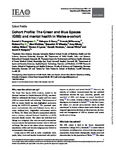Cohort Profile: The Green and Blue Spaces (GBS) and mental health in Wales e-cohort
| dc.contributor.author | Thompson, DA | |
| dc.contributor.author | Geary, RS | |
| dc.contributor.author | Rowney, FM | |
| dc.contributor.author | Fry, R | |
| dc.contributor.author | Watkins, A | |
| dc.contributor.author | Wheeler, BW | |
| dc.contributor.author | Mizen, A | |
| dc.contributor.author | Akbari, A | |
| dc.contributor.author | Lyons, RA | |
| dc.contributor.author | Stratton, G | |
| dc.contributor.author | White, J | |
| dc.contributor.author | Rodgers, SE | |
| dc.date.accessioned | 2022-08-25T10:29:30Z | |
| dc.date.issued | 2022-04-21 | |
| dc.identifier.issn | 0300-5771 | |
| dc.identifier.issn | 1464-3685 | |
| dc.identifier.uri | http://hdl.handle.net/10026.1/19569 | |
| dc.description.abstract |
Why was the cohort set up? The Green Blue Spaces (GBS) e-cohort, funded by the National Institute for Health Research (NIHR), was established to understand the impact of green and blue spaces (GBS) on mental health and wellbeing.1 The importance of GBS for mental health has been highlighted particularly during the COVID-19 pandemic.2 We processed opensource environmental data and Ordnance Survey data to create residence-level, longitudinal environment metrics for Wales, UK. These were linked to anonymised, administrative, routinely collected National Health Service (NHS) electronic health records. The cohort has individual-level linkage to a subgroup who were surveyed (cross-sectionally) to examine the association between visits to GBS and wellbeing. The size of the cohort allows examination of associations within and between subgroups not limited to socioeconomic disadvantage. Living close to GBS such as parks, woodlands, trails, ponds, lakes, rivers and beaches is associated with positive impacts on physical and mental health.3–6 However, the majority of evidence (cross-sectional) has not unpicked associations between the type, proximity, quantity and ‘qualities’ of GBS, and changes in mental health/wellbeing.7,8 As a result, existing evidence to inform policies shaping our environment is limited.9–11 In the first 3 years, the cohort will provide policy-relevant results on these associations1 to inform evidence-based public health, planning and regeneration decisions on the protection, development and management of GBS to promote and protect health and wellbeing. | |
| dc.format.extent | e285-e294 | |
| dc.format.medium | ||
| dc.language | en | |
| dc.language.iso | eng | |
| dc.publisher | Oxford University Press (OUP) | |
| dc.subject | Cohort Studies | |
| dc.subject | Humans | |
| dc.subject | Mental Health | |
| dc.subject | Parks, Recreational | |
| dc.subject | Residence Characteristics | |
| dc.subject | Wales | |
| dc.title | Cohort Profile: The Green and Blue Spaces (GBS) and mental health in Wales e-cohort | |
| dc.type | journal-article | |
| dc.type | Journal Article | |
| dc.type | Research Support, Non-U.S. Gov't | |
| plymouth.author-url | https://www.webofscience.com/api/gateway?GWVersion=2&SrcApp=PARTNER_APP&SrcAuth=LinksAMR&KeyUT=WOS:000784587300001&DestLinkType=FullRecord&DestApp=ALL_WOS&UsrCustomerID=11bb513d99f797142bcfeffcc58ea008 | |
| plymouth.issue | 5 | |
| plymouth.volume | 51 | |
| plymouth.publication-status | Published | |
| plymouth.journal | International Journal of Epidemiology | |
| dc.identifier.doi | 10.1093/ije/dyac080 | |
| plymouth.organisational-group | /Plymouth | |
| plymouth.organisational-group | /Plymouth/Faculty of Science and Engineering | |
| plymouth.organisational-group | /Plymouth/Faculty of Science and Engineering/School of Geography, Earth and Environmental Sciences | |
| plymouth.organisational-group | /Plymouth/Users by role | |
| plymouth.organisational-group | /Plymouth/Users by role/Academics | |
| dc.publisher.place | England | |
| dcterms.dateAccepted | 2022-04-05 | |
| dc.rights.embargodate | 2022-8-26 | |
| dc.identifier.eissn | 1464-3685 | |
| dc.rights.embargoperiod | Not known | |
| rioxxterms.versionofrecord | 10.1093/ije/dyac080 | |
| rioxxterms.licenseref.uri | http://www.rioxx.net/licenses/all-rights-reserved | |
| rioxxterms.licenseref.startdate | 2022-04-21 | |
| rioxxterms.type | Journal Article/Review |


